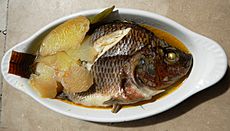Pinangat na isda facts for kids
 
|
|
| Type | Stew |
|---|---|
| Place of origin | Philippines |
| Region or state | Southern Luzon |
| Created by | Filipino cuisine |
| Main ingredients | Fish, tomatoes, salt, souring agent (calamansi, bilimbi, tamarind, santol, etc.) |
| Similar dishes | Sinigang, paksiw |
Pinangat na isda (pronounced pee-NAHNG-at nah IS-dah) is a yummy Filipino dish. It's also sometimes called pangat na isda. This stew comes from the Southern Luzon area of the Philippines. It's made with fish and tomatoes cooked in a sour broth.
The sour taste comes from fruits like calamansi (a small citrus fruit), bilimbi (a sour fruit), tamarind, or santol (a tropical fruit). You can also use pinangat na isda to cook shrimp. It's a bit like another Filipino soup called sinigang, but it's usually not as sour.
Pinangat na isda is sometimes confused with paksiw. Paksiw is a similar dish, but it mainly uses vinegar to make the broth sour. Pinangat na isda is also different from laing, which is a dish from the Bicol Region. Laing is sometimes called pinangat na laing, but they are not the same dish.
Contents
What is Pinangat na Isda?
Pinangat na isda is a traditional Filipino fish stew. It means "fish cooked in a sour broth." The word pinangat comes from the way the dish is cooked. It involves simmering ingredients in a small amount of liquid until they are tender.
How is Pinangat na Isda Made?
To make pinangat na isda, fresh fish is gently cooked with tomatoes. The key is the souring agent. Different fruits are used depending on what's available and the taste you want. These fruits give the broth its unique sour and tangy flavor.
- Fish: Usually, fresh whole fish or fish fillets are used.
- Tomatoes: These add a nice sweetness and color to the stew.
- Souring Agents:
The ingredients are simmered together until the fish is cooked through. The broth becomes flavorful from the fish, tomatoes, and souring fruit.
Pinangat na Isda vs. Similar Dishes
It's easy to mix up pinangat na isda with other Filipino dishes. But there are some clear differences.
Pinangat na Isda vs. Sinigang
Both pinangat na isda and sinigang are sour Filipino stews. However, sinigang is known for being much more sour. It often uses more souring agents and has a stronger sour taste. Pinangat na isda has a milder sourness.
Pinangat na Isda vs. Paksiw
Paksiw is another sour fish dish. The main difference is the souring agent. Paksiw uses vinegar as its main souring ingredient. Pinangat na isda uses fruits like calamansi or tamarind. This gives them different flavor profiles.
Pinangat na Isda vs. Laing
Laing is a completely different dish. It is a Bicolano dish made from taro leaves cooked in coconut milk. It is also sometimes called pinangat, but it does not contain fish. It's important not to confuse the two!
Why is Pinangat na Isda Popular?
Pinangat na isda is a favorite dish in the Philippines. It's simple to make and uses fresh, local ingredients. It's also a healthy meal, full of protein from the fish. The sour and savory flavors are very comforting and delicious. It's often served with steamed rice.

